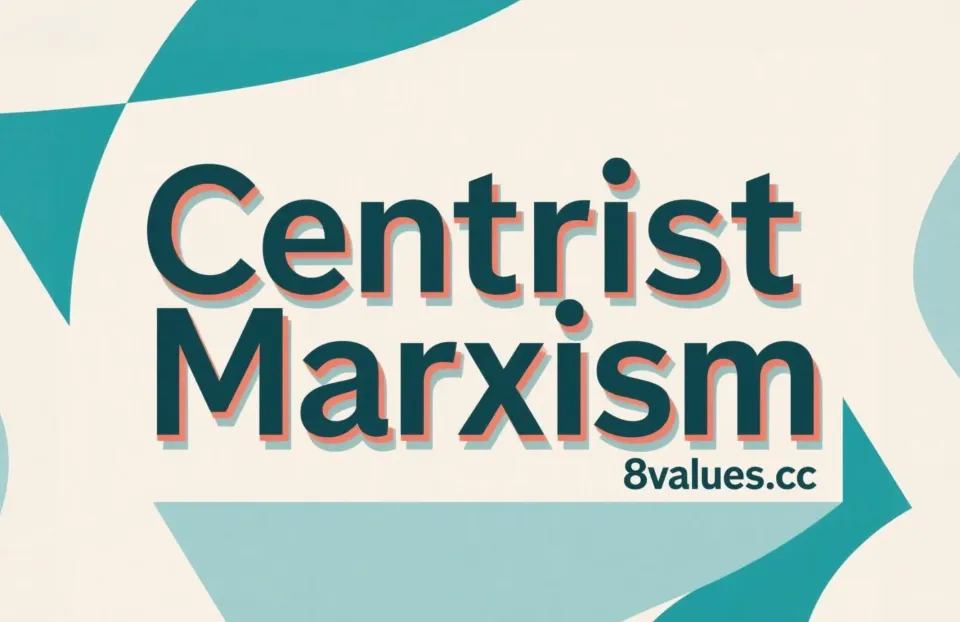An in-depth interpretation of Centrist Marxism: the third way between revolution and reform
Learn more about Centrist Marxism, a political stance between revolution and reform. This article will introduce in detail its historical background, core characteristics, representative figures, and the controversies and criticisms it has received in the Marxist movement. If you also want to explore your own political leanings, you are welcome to use the various testing tools provided by 8Values Political Ideology Tester.
In the vast spectrum of political ideologies, Marxism is by no means monolithic. It contains many schools and positions, such as Orthodox Marxism, Leninism, and Revisionism. For many first-time explorers of political theory, understanding these nuances is crucial. If you've ever come across the label "centrist Marxist" while taking the LeftValues political test or other political orientation tests, you may have been curious about it. Centrist Marxism is not a formal school of thought in the history of Marxist thought, but a descriptive term with the meaning of a political stance . It represents a particular position at the center of the spectrum of the Marxist movement.
What is Centrist Marxism: Core Definition and Positioning
Centrist Marxism, often referred to as "centrism", refers to the political position in the Marxist movement between revolution and reformism .
The birth of this concept must be understood in the context of the factional struggles of the socialist movement in the 20th century . Before and after World War I, three major camps were roughly formed within the international socialist movement:
- Left (revolutionary) : advocates the overthrow of capitalism through proletarian revolution and violent means. Representatives include Lenin and Trotsky.
- Right (reformist) : advocates the realization of socialism through parliamentary reform and gradual means. Representatives include Bernstein and later the Social Democratic majority.
- Centrist : Theoretically supports the goals of socialist revolution, but takes a moderate, gradual, or compromising position in practical strategies. It maintains a compromise or vacillating attitude between the gradual establishment of socialism through reforms and the overthrow of the capitalist system through revolution.
Therefore, "centrist Marxism" is a school of thought that attempts to find a middle way between Marxist revolutionary theory and reformist practice . It should be noted that the “centrist” here specifically refers to the position within Marxism, and it is difficult to regard it as a centrist in the general political spectrum. Typically, parties that pursue this ideology are still classified as left-wing parties.
The Swinging Position: The Ideological Characteristics of Centrist Marxism
The ideological characteristics of Centrist Marxism reflect its contradictions and struggles between theoretical principles and practical actions.
The contradiction between theory and practice
Centrist Marxists usually have the following distinctive characteristics:
- Theoretical support : They recognize the basic principles of Marxism such as class struggle, surplus value, and historical materialism.
- Moderate in practice : They tend to "wait for conditions to mature" or realize socialism "through democratic means" and are opposed to radical revolutionary means in practice .
- Swing and Opportunism : Centrists advocate revolution at some point in the future but at the same time urge reformist practices in the present . This characteristic of "revolutionary rhetoric contradicting reformist practice" was regarded by Trotskyists and other revolutionary Marxists as opportunistic.
ideological ambiguity
Centrist Marxism is often theoretically vague and eclectic. As it attempts to stand between the left and right, its theories are often unsystematic.
- Avoidance of theoretical obligations : It tends to avoid theoretical obligations, prioritizing (in rhetoric) “revolutionary practice” over theory, failing to recognize that only Marxist theory can provide revolutionary direction for practice.
- Critique of Parasitism : In terms of ideology, centrism is considered parasitic . It uses both reformist arguments against Marxists and Marxist arguments against the right, but avoids practical conclusions , thus weakening the edge of Marxist criticism.
- Orthodox posture : They claimed to adhere to "pure Marxism", but at the same time they criticized the "excessive" behavior of the Bolsheviks.
This avoidance of radical revolution and ambiguity in theory makes centrists politically considered to be "swingers who please both sides" and cannot represent the position of the proletariat at critical moments.
Historical examples: representative organizations and figures of centrist Marxism
The concept of centrist Marxism was widely used mainly in the international socialist movement in the early 20th century.
Represent political parties and organizations
Historically, many political parties have been seen as typical representatives of centrist Marxism:
- Independent Social Democratic Party of Germany (USPD) : This party vacillates between socialism through reform or socialism through revolution.
- The Independent Labor Party (ILP) : This party is also considered centrist because it oscillates between advocating for a socialist economy through reform and advocating for socialist revolution. British Trotskyist leader Ted Grant called the Independent Labor Party "a classic confused centrist".
- "Two and a Half International" and "Third and a Half International" : Parties belonging to the so-called "Second and a Half International" (the Socialist International Workers' Federation) and the "Third and a Half International" (the International Revolutionary Marxist Center) are typical representatives of centrism. These organizations were torn between the reformism of the social-democratic Berne International (Second International) and the revolutionary politics of the communist Third International.
- Other political parties : including the Spanish Marxist Workers' Party of Unity (POUM) and the Workers' Party of Zion (Poale Zion).
core thinkers
Karl Kautsky is one of the most representative "Marxist centrist" thinkers. He was the "Pope of the Second International" but later opposed Leninism, and his criticism of Bolshevism influenced democratic socialists in the United States. Kautsky was criticized for failing to raise the issue of the dictatorship of the proletariat in a timely manner in drawing a clear line between the Marxist and revisionist positions.
In addition, within the Bolshevik Party in the 1920s, the term "centrism" was also used to refer to a position between the Right Opposition, which supported the New Economic Policy and maintained friendly relations with capitalist countries, and the Left Opposition, which supported an immediate transition to a socialist economy and world revolution . It was not until the late 1920s that Joseph Stalin finally gained enough support to defeat the two opposing factions by applying various ideas articulated by their leaders, particularly Leon Trotsky and Nikolay Bukharin.
Criticisms of the Radical Left: Charges of Opportunism
For Trotskyists and other revolutionary Marxists, the term "centrism" often has a pejorative connotation . They described centrism as opportunism, believing that it was timid at critical moments of the revolution, lacked a clear political stance, and was even considered "politically unformed and lacked a clear political stance on the issues facing the revolutionary movement."
For example, the journal of the British Socialist Workers Party once described the British Independent Labor Party as "a centrist organization whose revolutionary rhetoric is at odds with its reformist practice." From a Trotskyist perspective, centrism attempts to stand between "Marxism and reformism."
This fate, called "pseudo-Marxists who cower at the moment of revolution" by revolutionaries and "unrealistic dogmatists" by reformists, is doomed to the fact that centrist Marxism lacks independent strength in practice and is ideologically attacked by the left and right. Eventually, as polarization intensified during the Cold War (CPSU versus Social Democrats), this centrist trend all but died out.
Extension and political ideology test in modern context
Although "Centrist Marxism" has gradually faded from the historical stage as an explicit organizational trend, the term is still occasionally used in modern contexts . It may be used for:
- Criticize certain moderate Marxist theorists , or describe "centrist socialists" who are both critical of capitalism and reject far-left revolutionary tactics.
- Used sarcastically in the context of online politics to refer to those who "talk about being Marxists but act like liberals."
If you want to get a more systematic understanding of where you stand on the political spectrum, including whether you lean towards a "centrist" position, you can take a professional self-assessment tool. For example, the 8Values Politics Test can help you understand your value tendencies across multiple dimensions, including economics, diplomacy, civil liberties, and society.
The exploration of political ideology is an in-depth learning process. After you understand complex historical concepts like Centrist Marxism, you can try more detailed political tests, such as the 9Axes Politics Test , to further refine your political profile. We encourage all readers who are interested in politics and ideology to visit the official blog of the 8Values Political Ideology Test website for more professional and in-depth knowledge interpretation, and use our political ideology test tool to find your exact position on the political spectrum.






